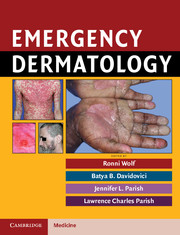Book contents
- Frontmatter
- Contents
- CONTRIBUTORS
- PREFACE
- Chap. 1 CELL INJURY AND CELL DEATH
- Chap. 2 CLEAN AND ASEPTIC TECHNIQUE AT THE BEDSIDE
- Chap. 3 NEW ANTIMICROBIALS
- Chap. 4 IMMUNOMODULATORS AND THE “BIOLOGICS” IN CUTANEOUS EMERGENCIES
- Chap. 5 CRITICAL CARE: STUFF YOU REALLY, REALLY NEED TO KNOW
- Chap. 6 ACUTE SKIN FAILURE: CONCEPT, CAUSES, CONSEQUENCES, AND CARE
- Chap. 7 CUTANEOUS SYMPTOMS AND NEONATAL EMERGENCIES
- Chap. 8 NECROTIZING SOFT-TISSUE INFECTIONS, INCLUDING NECROTIZING FASCIITIS
- Chap. 9 LIFE-THREATENING BACTERIAL SKIN INFECTIONS
- Chap. 10 BACTEREMIA, SEPSIS, SEPTIC SHOCK, AND TOXIC SHOCK SYNDROME
- Chap. 11 STAPHYLOCOCCAL SCALDED SKIN SYNDROME
- Chap. 12 LIFE-THREATENING CUTANEOUS VIRAL DISEASES
- Chap. 13 LIFE-THREATENING CUTANEOUS FUNGAL AND PARASITIC DISEASES
- Chap. 14 LIFE-THREATENING STINGS, BITES, AND MARINE ENVENOMATIONS
- Chap. 15 SEVERE, ACUTE ADVERSE CUTANEOUS DRUG REACTIONS I: STEVENS–JOHNSON SYNDROME AND TOXIC EPIDERMAL NECROLYSIS
- Chap. 16 SEVERE, ACUTE ADVERSE CUTANEOUS DRUG REACTIONS II: DRESS SYNDROME AND SERUM SICKNESS-LIKE REACTION
- Chap. 17 SEVERE, ACUTE COMPLICATIONS OF DERMATOLOGIC THERAPIES
- Chap. 18 SEVERE, ACUTE ALLERGIC AND IMMUNOLOGICAL REACTIONS I: URTICARIA, ANGIOEDEMA, MASTOCYTOSIS, AND ANAPHYLAXIS
- Chap. 19 SEVERE, ACUTE ALLERGIC AND IMMUNOLOGICAL REACTIONS II: OTHER HYPERSENSITIVITIES AND IMMUNE DEFECTS, INCLUDING HIV
- Chap. 20 GRAFT VERSUS HOST DISEASE
- Chap. 21 ERYTHRODERMA/EXFOLIATIVE DERMATITIS
- Chap. 22 ACUTE, SEVERE BULLOUS DERMATOSES
- Chap. 23 EMERGENCY MANAGEMENT OF PURPURA AND VASCULITIS, INCLUDING PURPURA FULMINANS
- Chap. 24 EMERGENCY MANAGEMENT OF CONNECTIVE TISSUE DISORDERS AND THEIR COMPLICATIONS
- Chap. 25 SKIN SIGNS OF SYSTEMIC INFECTIONS
- Chap. 26 SKIN SIGNS OF SYSTEMIC NEOPLASTIC DISEASES AND PARANEOPLASTIC CUTANEOUS SYNDROMES
- Chap. 27 BURN INJURY
- Chap. 28 EMERGENCY DERMATOSES OF THE ANORECTAL REGIONS
- Chap. 29 EMERGENCY MANAGEMENT OF SEXUALLY TRANSMITTED DISEASES AND OTHER GENITOURETHRAL DISORDERS
- Chap. 30 EMERGENCY MANAGEMENT OF ENVIRONMENTAL SKIN DISORDERS: HEAT, COLD, ULTRAVIOLET LIGHT INJURIES
- Chap. 31 ENDOCRINOLOGIC EMERGENCIES IN DERMATOLOGY
- Chap. 32 EMERGENCY MANAGEMENT OF SKIN TORTURE AND SELF-INFLICTED DERMATOSES
- Chap. 33 SKIN SIGNS OF POISONING
- Chap. 34 DISASTER PLANNING: MASS CASUALTY MANAGEMENT
- Chap. 35 CATASTROPHES IN COSMETIC PROCEDURES
- Chap. 36 LIFE-THREATENING DERMATOSES IN TRAVELERS
- Index
- References
Chap. 30 - EMERGENCY MANAGEMENT OF ENVIRONMENTAL SKIN DISORDERS: HEAT, COLD, ULTRAVIOLET LIGHT INJURIES
Published online by Cambridge University Press: 07 September 2011
- Frontmatter
- Contents
- CONTRIBUTORS
- PREFACE
- Chap. 1 CELL INJURY AND CELL DEATH
- Chap. 2 CLEAN AND ASEPTIC TECHNIQUE AT THE BEDSIDE
- Chap. 3 NEW ANTIMICROBIALS
- Chap. 4 IMMUNOMODULATORS AND THE “BIOLOGICS” IN CUTANEOUS EMERGENCIES
- Chap. 5 CRITICAL CARE: STUFF YOU REALLY, REALLY NEED TO KNOW
- Chap. 6 ACUTE SKIN FAILURE: CONCEPT, CAUSES, CONSEQUENCES, AND CARE
- Chap. 7 CUTANEOUS SYMPTOMS AND NEONATAL EMERGENCIES
- Chap. 8 NECROTIZING SOFT-TISSUE INFECTIONS, INCLUDING NECROTIZING FASCIITIS
- Chap. 9 LIFE-THREATENING BACTERIAL SKIN INFECTIONS
- Chap. 10 BACTEREMIA, SEPSIS, SEPTIC SHOCK, AND TOXIC SHOCK SYNDROME
- Chap. 11 STAPHYLOCOCCAL SCALDED SKIN SYNDROME
- Chap. 12 LIFE-THREATENING CUTANEOUS VIRAL DISEASES
- Chap. 13 LIFE-THREATENING CUTANEOUS FUNGAL AND PARASITIC DISEASES
- Chap. 14 LIFE-THREATENING STINGS, BITES, AND MARINE ENVENOMATIONS
- Chap. 15 SEVERE, ACUTE ADVERSE CUTANEOUS DRUG REACTIONS I: STEVENS–JOHNSON SYNDROME AND TOXIC EPIDERMAL NECROLYSIS
- Chap. 16 SEVERE, ACUTE ADVERSE CUTANEOUS DRUG REACTIONS II: DRESS SYNDROME AND SERUM SICKNESS-LIKE REACTION
- Chap. 17 SEVERE, ACUTE COMPLICATIONS OF DERMATOLOGIC THERAPIES
- Chap. 18 SEVERE, ACUTE ALLERGIC AND IMMUNOLOGICAL REACTIONS I: URTICARIA, ANGIOEDEMA, MASTOCYTOSIS, AND ANAPHYLAXIS
- Chap. 19 SEVERE, ACUTE ALLERGIC AND IMMUNOLOGICAL REACTIONS II: OTHER HYPERSENSITIVITIES AND IMMUNE DEFECTS, INCLUDING HIV
- Chap. 20 GRAFT VERSUS HOST DISEASE
- Chap. 21 ERYTHRODERMA/EXFOLIATIVE DERMATITIS
- Chap. 22 ACUTE, SEVERE BULLOUS DERMATOSES
- Chap. 23 EMERGENCY MANAGEMENT OF PURPURA AND VASCULITIS, INCLUDING PURPURA FULMINANS
- Chap. 24 EMERGENCY MANAGEMENT OF CONNECTIVE TISSUE DISORDERS AND THEIR COMPLICATIONS
- Chap. 25 SKIN SIGNS OF SYSTEMIC INFECTIONS
- Chap. 26 SKIN SIGNS OF SYSTEMIC NEOPLASTIC DISEASES AND PARANEOPLASTIC CUTANEOUS SYNDROMES
- Chap. 27 BURN INJURY
- Chap. 28 EMERGENCY DERMATOSES OF THE ANORECTAL REGIONS
- Chap. 29 EMERGENCY MANAGEMENT OF SEXUALLY TRANSMITTED DISEASES AND OTHER GENITOURETHRAL DISORDERS
- Chap. 30 EMERGENCY MANAGEMENT OF ENVIRONMENTAL SKIN DISORDERS: HEAT, COLD, ULTRAVIOLET LIGHT INJURIES
- Chap. 31 ENDOCRINOLOGIC EMERGENCIES IN DERMATOLOGY
- Chap. 32 EMERGENCY MANAGEMENT OF SKIN TORTURE AND SELF-INFLICTED DERMATOSES
- Chap. 33 SKIN SIGNS OF POISONING
- Chap. 34 DISASTER PLANNING: MASS CASUALTY MANAGEMENT
- Chap. 35 CATASTROPHES IN COSMETIC PROCEDURES
- Chap. 36 LIFE-THREATENING DERMATOSES IN TRAVELERS
- Index
- References
Summary
ENVIRONMENTAL SKIN disorders usually are associated with ambient changes (heat, humidity, intensity of ultraviolet [UV] solar rays) and new environments (ski slopes, beaches, jungles/rainforests, and areas with exotic animals unfamiliar to patients). Many of these new surroundings cause unique dermatologic reactions familiar to natives who understand the need for avoidance but unfamiliar to others who must seek dermatologic care.
PROPER AND EARLY MANAGEMENT
Proper and early management of skin disorders due to environmental factors might avert the ruin of a long anticipated trip or vacation. In some instances, the environmental exposure occurs at home before departure and then is manifested during travel to – or at – the destination. Such environmental exposures from contact allergens, toxins, and infections or infestations can be delayed. As a result, clinical manifestations are delayed and may not appear until several days after the return home. Likewise, the necessary therapy may be required in that wide window – the so-called incubation period. The challenge of many of the environmentally associated emergencies is to initiate therapy early, to achieve the best possible outcome, and, in some infectious complications, to be able to institute the now-delayed therapy to avoid great increases in morbidity and mortality.
- Type
- Chapter
- Information
- Emergency Dermatology , pp. 293 - 297Publisher: Cambridge University PressPrint publication year: 2011

